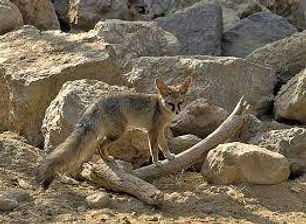Blanford's Fox(Vulpes cana)
Blanford's fox is a small fox with wide ears and a long, bushy tail nearly equal to the length of its body. Its body size often varies geographically. The body is brownish-grey, fading to light yellow on the belly. The winter coat is soft and woolly, with a dense black undercoat and white fur speckles in the dorsal area; together with a somewhat thicker layer of fat, it serves as thermal insulation in cold and dry winter.

The summer coat is less thick, the fur is paler, and the white hair is less noticeable. A characteristic mid-dorsal black band extends caudally from the nape of the spine, becoming a mid-dorsal crest along the length of the tail. The tail is the same colour as the body. A black spot is found at the base of the spine. The tip of the tail is normally black, but it is white in some individuals. The dark mid-dorsal line, which is a distinctive characteristic of the Israeli specimens, is less noticeable in Oman specimens, although the black tail markings are similarly developed. Like other arid land foxes, Blanford's fox characteristically large ear is an adaptation to enhance heat dissipation. However, unlike other desert foxes, it does not have pads covered with hair, and it has cat-like, curved, sharp claws described by some authors as semiretractile. This fox has an ability to climb rocks and make jumps described as astonishing, jumping to ledges 3 m above them with ease, and as part of their regular movements and climbing vertical, crumbling cliffs by a series of jumps up vertical sections. The foxes use their sharp, curved claws and naked footpads for traction on narrow ledges and their long, bushy tails as a counterbalance.
Habitat
Blanford's Foxes are found in the semi-arid regions, steppes and mountains in west and south Asia. The Blanford's fox has a rather discontinuous range. Initially known only from southwest Asia, this species was reported in Israel in 1981 and was later found to be more widespread in the Arabian Peninsula.

Diet
Blanford's fox is omnivorous and primarily insectivorous and frugivorous. They are almost always solitary foragers, only foraging in pairs on occasion. Unlike other fox species, it seldom caches food. They mainly feed on fruit, such as melons and grapes, insects and rodents.
Breeding
Blanford's foxes are thought to be strictly monogamous. Monogamy may be beneficial in this species as the dispersion of their prey is such that, in order to accommodate additional adults, it would demand a territorial expansion that would bring more costs than benefits. Females are monoestrus and come into heat during January–February. Gestation period is around 50–60 days, and litter size is one to three. The lactation period is 30–45 days. Neonates are born with soft, black fur, with an estimated body mass of 29 g. At the age of two months, the kits start to forage with one of the parents, and at 3 months of age they begin to forage on their own. Juveniles have similar markings as adults, but their fur is darker and more grayish. Sexual maturity is reached at the age of 10–12 months. Average lifespan of Blandford's foxes is 4 to 5 years, and does not exceed 10 years in the wild.
Population
According to the IUCN Red List, they are classed as Least Concern(LC). Their population trend is currently stable. They were last assessed on 22nd July 2015. The number of mature individuals is unknown.
Threats
There are currently no obvious major threats resulting in range-wide declines of Blanford's Fox. However, general habitat loss, due mainly to expanding settlement and tourism development, and human persecution and indirect mortality, do pose localized threats. In Israel, habitat loss is limited as most of the area where this species occurs is designated as protected. However, political developments may change the status of the northern Judaean Desert, and human development along the Dead Sea coasts may also pose a considerable threat to existing habitat. Similar concerns exist for the populations in the United Arab Emirates. Indirect mortality is usually a result of animals being killed incidentally through carcass poisoning of other target species, such as hyaenas and wolves. The current situation in Iran and Pakistan is unknown.
Conservation
Legislation
This species is listed on CITES – Appendix II. It is fully protected in Israel, with no hunting, trapping or trading permitted. Holding in captivity requires a special permit from the Nature Reserves Authority of Israel. There is a ban on hunting in Jordan and Oman. However, there is no legal protection in Egypt, Saudi Arabia, U.A.E., Iran, Afghanistan or Pakistan.
Presence in protected areas
The species occurs in protected areas in Iran, Israel, Jordan, Oman, Saudi Arabia, United Arab Emirates and Yemen.
Presence in captivity
In Israel, the species is kept in captivity at the Hai Bar Breeding Centre (near Eilat). In previous years, there was a pair at the Tel Aviv University Zoo. Captive individuals are also kept at the Breeding Centre for Endangered Arabian Wildlife, Sharjah, U.A.E. Foxes have been successfully bred at all the above facilities.
Research needs
The information on the biology of Blanford's Foxes is mostly from the southern part of Israel. Little is known on the behaviour and ecology of the species in the eastern part of its distribution. Further information on the distribution of the species in Egypt would also be useful. Interactions with other predators (including potential competition with Red Fox Vulpes vulpes) and the susceptibility to diseases are poorly understood.